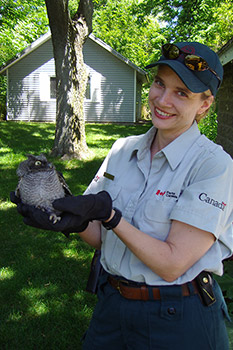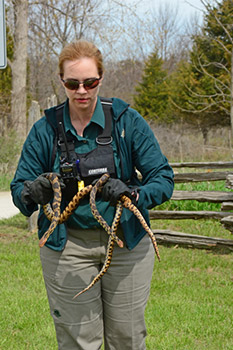Meet Kelly Scott
Point Pelee National Park

Job Title
Resource Management Officer II
What was your education/career path?
I have an Honours Bachelor of Science with a specialization in Wildlife Biology from the University of Guelph and a Post-Degree Certificate in Ecosystem Restoration from Niagara College.
What drew you to Point Pelee? When did you first start working at Point Pelee National Park?
Love and opportunity in 2002! Part of what drew me to working at Parks Canada was the opportunity to move around and get jobs at many sites across the country. My first job was as a Park Warden at Thousand Islands National Park when a work assignment opportunity became available at Point Pelee. My husband was finishing up his Masters Degree at the University of Guelph and Pelee was a closer commute for us. I wanted the chance to work in a biodiverse environment and gain new, valuable experiences at another national park.
What do you do for Parks Canada?

My main role is as an Impact Assessment Practitioner for protected heritage places in Southwestern Ontario. These treasured places include a biologically rich and diverse national park (Point Pelee), as well as several national historic sites, which includes 3 forts from the War of 1812 (Fort Malden, Fort George, and Fort Mississauga), a Prime Minister’s boyhood home (Woodside), and a World War II Tribal Class Destroyer vessel (HMCS Haida).
As an Impact Assessment Practitioner, I coordinate, write, review, and monitor impact assessments for projects and special events, which are triggered under federal laws and policies. Impact assessments are reports that provide advice to managers about how to reduce effects of their projects or events on Parks Canada sites. It’s a very detail driven role that requires a general knowledge about a variety of different fields including ecology, restoration, cultural resources, visitor experience and safety, project management, and building design. Depending on the nature of the project or event, there may also be a need to engage and consult with Indigenous Peoples and the general public to make sure their knowledge, ideas, and concerns are captured in the process.
What I really enjoy is being able to occasionally work outside at the sites, as well as to interact with many expert staff across the country like Asset-Project Managers, Cultural Resource Advisors, Terrestrial Archaeologists, Impact Assessment Scientists, and Species Conservation Specialists. I learn a lot from these folks every day, which helps to keep my job interesting and fresh.
What would you tell a young girl about working in science, technology, engineering and mathematics (STEM)?
If you enjoy any or all of the STEM subjects in school, then just apply yourself. Figure out what you love to do the most and where you could see yourself working in a few years. Do you picture yourself inside a lab or office, or outside in the great outdoors carrying out fieldwork? Do you like working with people or rocks or animals or space robots? Do you like low key, quiet, repetitive tasks, or do you wish every day was an exciting, new adventure?
Read up on different careers, and what universities, colleges, and trade schools have to offer for people pursuing jobs in STEM. Check in with your high school guidance counsellor to get some direction and resources to help you get started in figuring out what you truly like to do, as well as what you can see yourself working towards in the future.
Get experience working in the field. Don’t let people tell you that you will never get a job in your field. I always worked hard and managed to find a job which had something to do with STEM and build my resume. Each of these STEM related jobs helped me work towards where I wanted to be, which was working as a Park Warden at Parks Canada. Everyone should equally have the chance to pursue their STEM dream!
- Date modified :